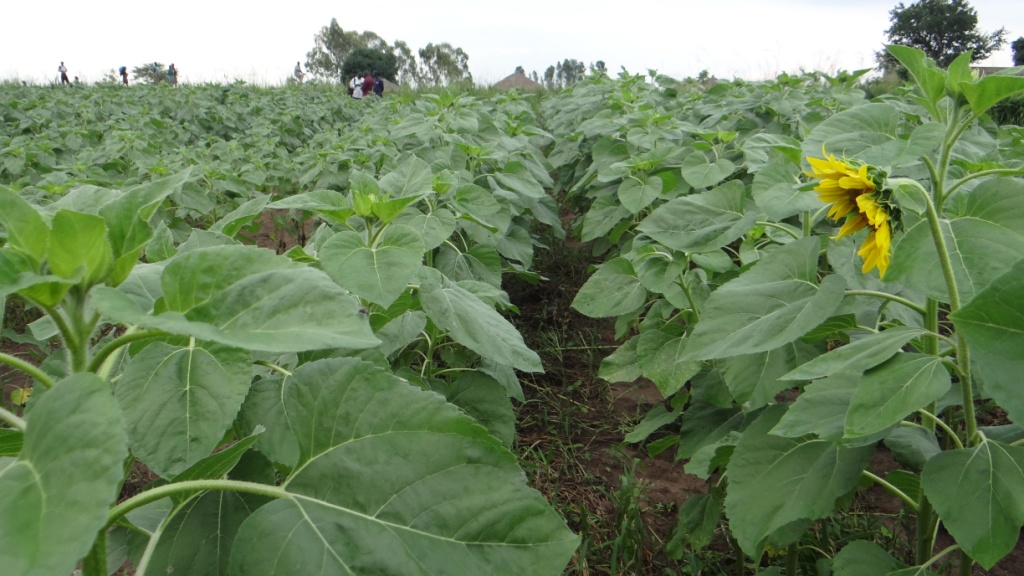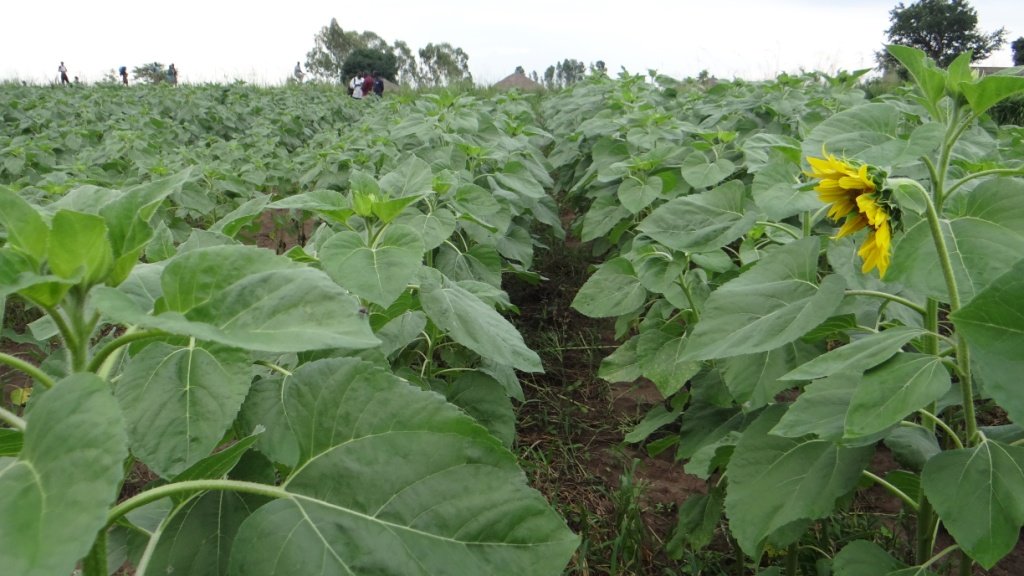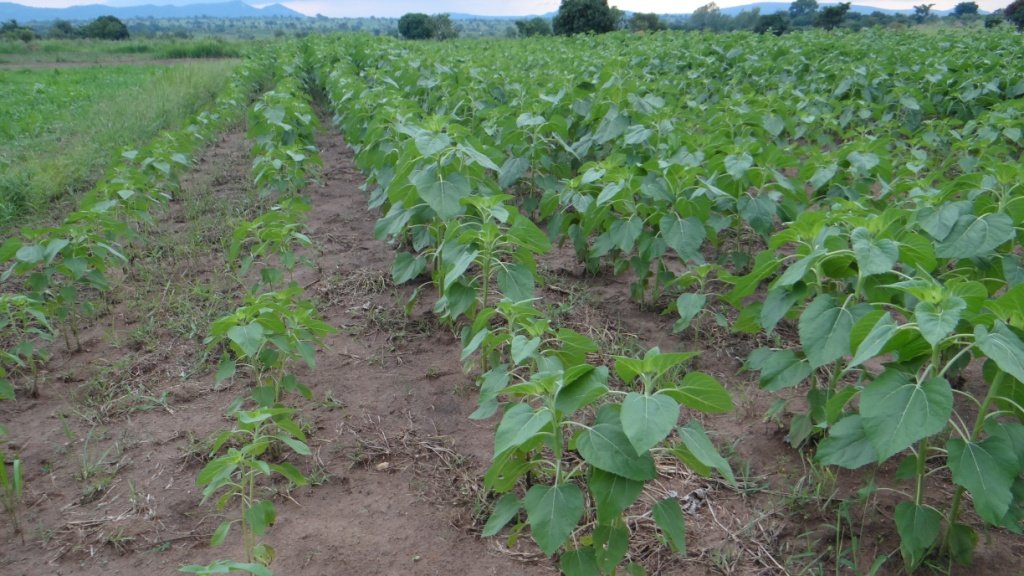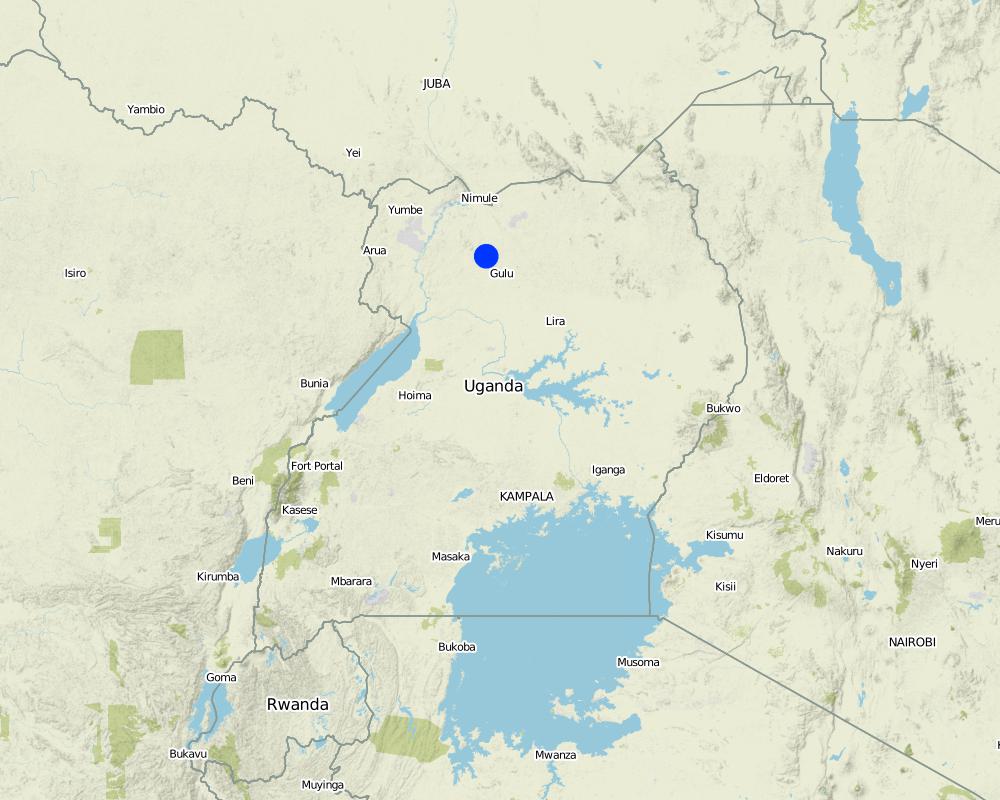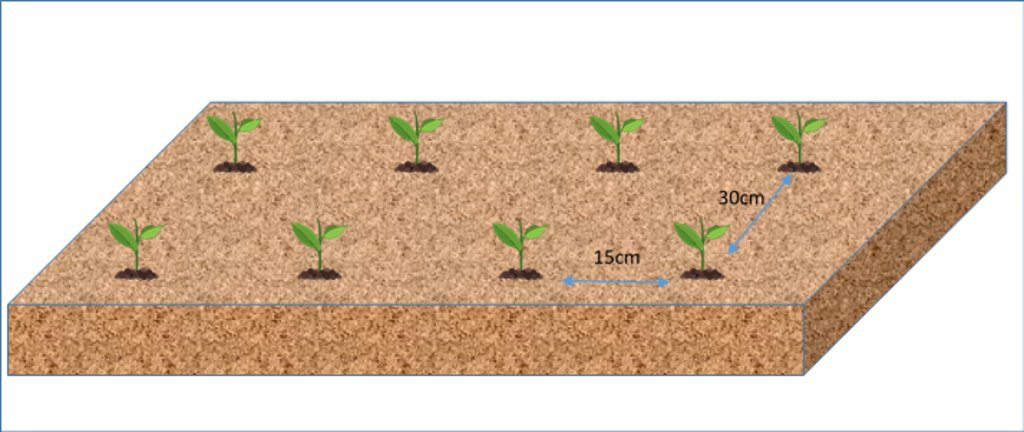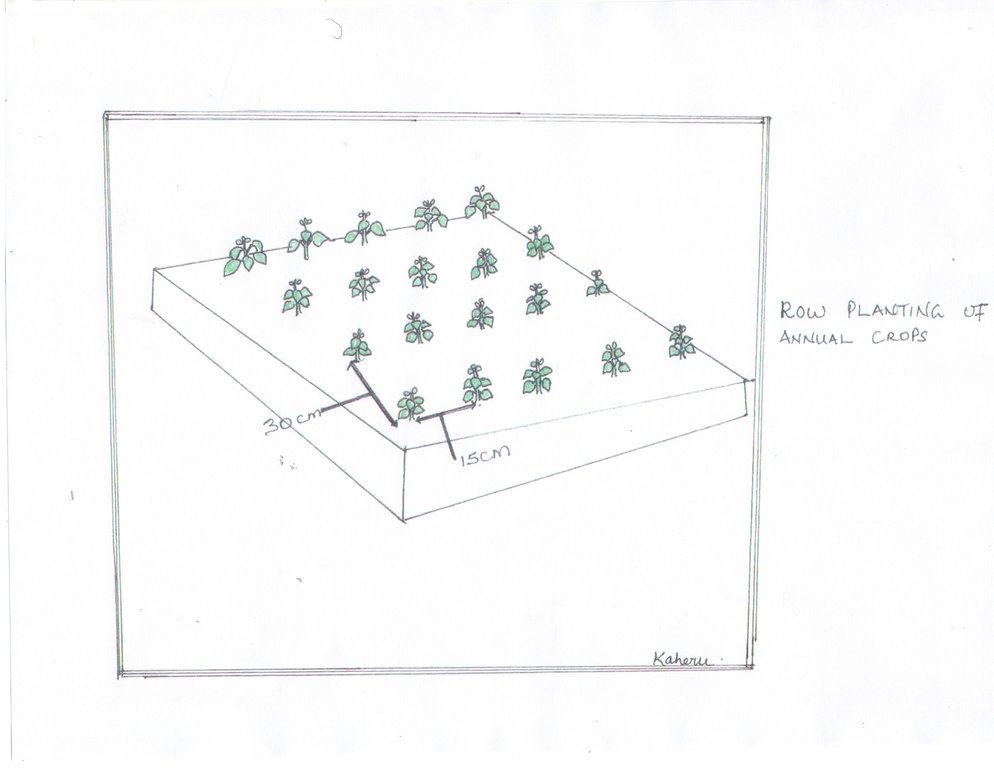Row planting of annual crops [Uganda]
- Creation:
- Update:
- Compiler: Kamugisha Rick Nelson
- Editors: JOY TUKAHIRWA, Richard Otto Kawawa, Sunday Balla Amale, Bernard Fungo
- Reviewers: John Stephen Tenywa, Nicole Harari, Renate Fleiner, Stephanie Jaquet, Donia Mühlematter
Pito kodi iline
technologies_2814 - Uganda
View sections
Expand all Collapse all1. General information
1.2 Contact details of resource persons and institutions involved in the assessment and documentation of the Technology
Key resource person(s)
land user:
Obwona David
0779947866
Farmer
Palwong-Katikakati B, Pabbo Sub-county Amuru District
Uganda
Name of project which facilitated the documentation/ evaluation of the Technology (if relevant)
Scaling-up SLM practices by smallholder farmers (IFAD)Name of the institution(s) which facilitated the documentation/ evaluation of the Technology (if relevant)
CDE Centre for Development and Environment (CDE Centre for Development and Environment) - Switzerland1.3 Conditions regarding the use of data documented through WOCAT
When were the data compiled (in the field)?
26/05/2017
The compiler and key resource person(s) accept the conditions regarding the use of data documented through WOCAT:
Ja
1.4 Declaration on sustainability of the described Technology
Is the Technology described here problematic with regard to land degradation, so that it cannot be declared a sustainable land management technology?
Nee
2. Description of the SLM Technology
2.1 Short description of the Technology
Definition of the Technology:
In row planting, crops are planted according to the recommended agronomic spacing to ease management and obtain maximum yields per unit area.
2.2 Detailed description of the Technology
Description:
In this practice, the farmer planted sunflower (Helianthus) seeds at a spacing recommended for the particular variety. Sunflower variety PAN7033 and AGISUN was cultivated on 1 acre of land at a spacing of 15cm within row and 30cm between rows.
To plant crops in a row, the farmer has to ensure that the field is finely prepared. During planting, pegs are fitted at a spacing corresponding to spaces between the rows (30cm), along the width of the field. Ropes are then tied on the pegs along the length of the field. The rope guides the person who will be digging the planting holes, while another person would be dropping the seeds in the holes. After digging the holes in a row, the rope is transferred to the next set of pegs and the process is repeated. These activities require a minimum of 10 people to be working on the farm in order to plant 1 acre of sunflower in a day.
In this way; high yield is obtained from the crop. Activities like weeding, spraying, fertilizer application, harvesting becomes easy hence labor demand is reduced. Although there are elaborate gardening pegs and ropes in the market, the rope and pegs can be made from locally available materials hence reducing costs. Crop planted in rows may reduce surface runoff by planting in a homogenous way and improve maintain a consistent soil cover.
2.3 Photos of the Technology
2.4 Videos of the Technology
Comments, short description:
Video showing row planting of annual crops (sunflower) in Amuru District.
Date:
26/05/2017
Location:
Amuru District, Northern Uganda
Name of videographer:
Issa Aiga
2.5 Country/ region/ locations where the Technology has been applied and which are covered by this assessment
Country:
Uganda
Region/ State/ Province:
Northern Region,Uganda
Further specification of location:
Amuru District
Comments:
Map showing technology site in Northern Uganda.
Map
×2.6 Date of implementation
Indicate year of implementation:
2015
If precise year is not known, indicate approximate date:
- less than 10 years ago (recently)
2.7 Introduction of the Technology
Specify how the Technology was introduced:
- through projects/ external interventions
3. Classification of the SLM Technology
3.1 Main purpose(s) of the Technology
- improve production
- create beneficial economic impact
3.2 Current land use type(s) where the Technology is applied

Cropland
- Annual cropping
Main crops (cash and food crops):
Soya bean, sunflower and maize.
3.3 Further information about land use
Water supply for the land on which the Technology is applied:
- rainfed
Number of growing seasons per year:
- 2
Specify:
1st and 2nd season
3.4 SLM group to which the Technology belongs
- rotational systems (crop rotation, fallows, shifting cultivation)
- improved ground/ vegetation cover
3.5 Spread of the Technology
Specify the spread of the Technology:
- applied at specific points/ concentrated on a small area
3.6 SLM measures comprising the Technology

agronomic measures
- A1: Vegetation/ soil cover
- A6: Others

structural measures
- S11: Others

management measures
- M2: Change of management/ intensity level
3.7 Main types of land degradation addressed by the Technology

soil erosion by water
- Wt: loss of topsoil/ surface erosion

chemical soil deterioration
- Cn: fertility decline and reduced organic matter content (not caused by erosion)
3.8 Prevention, reduction, or restoration of land degradation
Specify the goal of the Technology with regard to land degradation:
- reduce land degradation
4. Technical specifications, implementation activities, inputs, and costs
4.1 Technical drawing of the Technology
4.2 Technical specifications/ explanations of technical drawing
Dimensions: The line is opened using a rope together with pegs. Marking is done according to spacing of 15cm within a row and 30cm between rows.
4.3 General information regarding the calculation of inputs and costs
Specify how costs and inputs were calculated:
- per Technology area
Indicate size and area unit:
1 acre
other/ national currency (specify):
UGX
Indicate exchange rate from USD to local currency (if relevant): 1 USD =:
3600.0
Indicate average wage cost of hired labour per day:
5000
4.4 Establishment activities
| Activity | Type of measure | Timing | |
|---|---|---|---|
| 1. | Land opening (Clearing the bush before planting) | Agronomic | Once before establishment |
| 2. | 2 degrees tillage | Agronomic | Once before establishment |
| 3. | Marking line | Structural | During establishment |
| 4. | Digging | Management | During establishment |
| 5. | Seeding | Agronomic | During establishment |
| 6. | Weeding | Management | After establishment |
| 7. | Harvesting | Agronomic | After establishment |
4.5 Costs and inputs needed for establishment
| Specify input | Unit | Quantity | Costs per Unit | Total costs per input | % of costs borne by land users | |
|---|---|---|---|---|---|---|
| Labour | Labour for planting | Persons | 10.0 | 5000.0 | 50000.0 | 100.0 |
| Equipment | Hoes | Pieces | 3.0 | 10000.0 | 30000.0 | 100.0 |
| Equipment | pegs | Pieces | 6.0 | 2000.0 | 12000.0 | 100.0 |
| Equipment | ropes | Rolls | 1.0 | 10000.0 | 10000.0 | 100.0 |
| Plant material | Seeds | Kgs | 30.0 | 5000.0 | 150000.0 | 100.0 |
| Total costs for establishment of the Technology | 252000.0 | |||||
Comments:
This cost is calculated per acre for the technology for soya bean because there are other crops.
4.6 Maintenance/ recurrent activities
| Activity | Type of measure | Timing/ frequency | |
|---|---|---|---|
| 1. | Monitoring | Management | Once a year |
| 2. | Harvesting | Management | once a year |
4.7 Costs and inputs needed for maintenance/ recurrent activities (per year)
| Specify input | Unit | Quantity | Costs per Unit | Total costs per input | % of costs borne by land users | |
|---|---|---|---|---|---|---|
| Labour | Labour for harvesting and monitoring. | persons | 5.0 | 5000.0 | 25000.0 | 100.0 |
| Total costs for maintenance of the Technology | 25000.0 | |||||
4.8 Most important factors affecting the costs
Describe the most determinate factors affecting the costs:
Labour for planting, weeding and harvesting takes the most of costs.
5. Natural and human environment
5.1 Climate
Annual rainfall
- < 250 mm
- 251-500 mm
- 501-750 mm
- 751-1,000 mm
- 1,001-1,500 mm
- 1,501-2,000 mm
- 2,001-3,000 mm
- 3,001-4,000 mm
- > 4,000 mm
Agro-climatic zone
- sub-humid
5.2 Topography
Slopes on average:
- flat (0-2%)
- gentle (3-5%)
- moderate (6-10%)
- rolling (11-15%)
- hilly (16-30%)
- steep (31-60%)
- very steep (>60%)
Landforms:
- plateau/plains
- ridges
- mountain slopes
- hill slopes
- footslopes
- valley floors
Altitudinal zone:
- 0-100 m a.s.l.
- 101-500 m a.s.l.
- 501-1,000 m a.s.l.
- 1,001-1,500 m a.s.l.
- 1,501-2,000 m a.s.l.
- 2,001-2,500 m a.s.l.
- 2,501-3,000 m a.s.l.
- 3,001-4,000 m a.s.l.
- > 4,000 m a.s.l.
Indicate if the Technology is specifically applied in:
- not relevant
5.3 Soils
Soil depth on average:
- very shallow (0-20 cm)
- shallow (21-50 cm)
- moderately deep (51-80 cm)
- deep (81-120 cm)
- very deep (> 120 cm)
Soil texture (topsoil):
- medium (loamy, silty)
Soil texture (> 20 cm below surface):
- medium (loamy, silty)
Topsoil organic matter:
- medium (1-3%)
5.4 Water availability and quality
Ground water table:
5-50 m
Availability of surface water:
medium
Water quality (untreated):
good drinking water
Is water salinity a problem?
Nee
Is flooding of the area occurring?
Nee
5.5 Biodiversity
Species diversity:
- low
Habitat diversity:
- low
Comments and further specifications on biodiversity:
low lying land
5.6 Characteristics of land users applying the Technology
Sedentary or nomadic:
- Sedentary
Market orientation of production system:
- subsistence (self-supply)
Off-farm income:
- less than 10% of all income
Relative level of wealth:
- poor
Individuals or groups:
- individual/ household
Level of mechanization:
- manual work
- animal traction
Gender:
- women
- men
Age of land users:
- youth
- middle-aged
Indicate other relevant characteristics of the land users:
The land user has domestic animals (chicken and animals for traction).
5.7 Average area of land owned or leased by land users applying the Technology
- < 0.5 ha
- 0.5-1 ha
- 1-2 ha
- 2-5 ha
- 5-15 ha
- 15-50 ha
- 50-100 ha
- 100-500 ha
- 500-1,000 ha
- 1,000-10,000 ha
- > 10,000 ha
Is this considered small-, medium- or large-scale (referring to local context)?
- small-scale
Comments:
Holds approximately 10 acres and rent about 5 acres from other land users.
5.8 Land ownership, land use rights, and water use rights
Land ownership:
- individual, not titled
Land use rights:
- leased
- individual
Water use rights:
- leased
- individual
Comments:
Owned land =10 cares and leased land =5 acres.
5.9 Access to services and infrastructure
health:
- poor
- moderate
- good
education:
- poor
- moderate
- good
technical assistance:
- poor
- moderate
- good
employment (e.g. off-farm):
- poor
- moderate
- good
markets:
- poor
- moderate
- good
energy:
- poor
- moderate
- good
roads and transport:
- poor
- moderate
- good
drinking water and sanitation:
- poor
- moderate
- good
financial services:
- poor
- moderate
- good
6. Impacts and concluding statements
6.1 On-site impacts the Technology has shown
Socio-economic impacts
Production
crop production
Comments/ specify:
High yield and pod filling.
land management
Comments/ specify:
Row planting technique.
Income and costs
expenses on agricultural inputs
Comments/ specify:
Especially on labour.
farm income
Comments/ specify:
From the sale of harvests (soya and sunflower).
Ecological impacts
Soil
soil cover
Comments/ specify:
Soil organic matter increased due to application of soya residues
nutrient cycling/ recharge
Comments/ specify:
Use of the soya bean residues.
soil organic matter/ below ground C
Comments/ specify:
Soil organic matter increased due to application of soya residues.
6.2 Off-site impacts the Technology has shown
Comments regarding impact assessment:
None
6.3 Exposure and sensitivity of the Technology to gradual climate change and climate-related extremes/ disasters (as perceived by land users)
Gradual climate change
Gradual climate change
| Season | Type of climatic change/ extreme | How does the Technology cope with it? | |
|---|---|---|---|
| annual temperature | increase | well | |
| seasonal temperature | wet/ rainy season | increase | moderately |
6.4 Cost-benefit analysis
How do the benefits compare with the establishment costs (from land users’ perspective)?
Short-term returns:
slightly positive
Long-term returns:
positive
How do the benefits compare with the maintenance/ recurrent costs (from land users' perspective)?
Short-term returns:
slightly positive
Long-term returns:
positive
6.5 Adoption of the Technology
- 1-10%
Of all those who have adopted the Technology, how many have did so spontaneously, i.e. without receiving any material incentives/ payments?
- 0-10%
6.6 Adaptation
Has the Technology been modified recently to adapt to changing conditions?
Nee
6.7 Strengths/ advantages/ opportunities of the Technology
| Strengths/ advantages/ opportunities in the land user’s view |
|---|
| Easy to establish using a rope which is cheap. |
| Easy to establish and manage with minimum costs. |
| Good at controlling soil and water runoffs |
| The technology can easily be replicated and used by both small scale and large scale farmers. |
| Strengths/ advantages/ opportunities in the compiler’s or other key resource person’s view |
|---|
| Yield potential is high and realized when the spacing is done well by the land user according to recommended spacing. |
6.8 Weaknesses/ disadvantages/ risks of the Technology and ways of overcoming them
| Weaknesses/ disadvantages/ risks in the land user’s view | How can they be overcome? |
|---|---|
| Labour intensive at the time of establishment. | Use group labour. |
| Time consuming during establishment. | Use group labour to save on time. |
| Requires technical knowledge especially on the spacing. | Provide information early enough to the land user on the required spacing. |
| Weaknesses/ disadvantages/ risks in the compiler’s or other key resource person’s view | How can they be overcome? |
|---|---|
| The land user does not Incorporate Integrated Soil Fertility Management (ISFM) yet has livestock manure. | Advice to integrate animal manure in row planting. |
7. References and links
7.1 Methods/ sources of information
- field visits, field surveys
Links and modules
Expand all Collapse allLinks
No links
Modules
No modules


